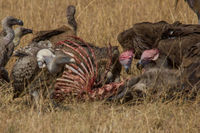Vulture
 From Conservapedia
From Conservapedia | Vulture | |
|---|---|

| |
| White-backed vultures (Gyps africanus, left) Rüppell's griffon vulture (Gyps rueppellii, foreground) Lappet-faced vultures (Torgos tracheliotos, right) | |
| Scientific classification | |
| Kingdom Information | |
| Domain | Eukaryota |
| Kingdom | Animalia |
| Subkingdom | Bilateria |
| Phylum Information | |
| Phylum | Chordata |
| Sub-phylum | Vertebrata |
| Infraphylum | Gnathostomata |
| Class Information | |
| Superclass | Tetrapoda |
| Class | Aves |
| Sub-class | Neornithes |
| Order Information | |
| Order | Accipitriformes |
| Population statistics | |
Vulture refers to 23 species of scavenging birds of the order Accipitriformes, comprising two families distantly related to each other: the New World vultures of the family Cathartidae, and the Old World vultures of the family Accipitridae, whose relatives include eagles, hawks, and kites.
Contents
- 1 Description
- 2 Species
- 2.1 New World vultures
- 2.2 Old World vultures
Description[edit]
Vultures range in size from the crow-sized Egyptian vulture to the very large condors of the Americas, among the largest living flying birds. With few exceptions, vultures possess a head and neck devoid of feathers, enabling them to reach well inside animal carcasses without matting their feathers with blood. They have weak feet, adapted for walking rather than killing prey. Their wings are large and broad, which they use for effortless soaring. Eyesight is powerful in all species, and they can locate a carcass up to a mile away, while in a few New World species the sense of smell is also used, a rarity among birds.
Apart from Australia and many oceanic islands, vultures are worldwide, found generally in the tropics, with a few species ranging into temperate zones. They are open-country birds, spending hours aloft soaring on thermal updrafts to locate a dead or dying animal; when found a large flock will quickly gather, often from miles away. A social order takes place on the carcass, with the birds bearing the largest size feeding first, followed by the smaller birds. All give way, however, to any mammal scavenger who comes upon the carcass, such as hyenas and jackals.
Old World vultures build nests, usually large, and sometimes in large colonies, laying a single egg. New World vultures lay as much as two eggs in tree or cliff cavities, with none nesting in a colony.
Species[edit]
New World vultures[edit]
Found in the Americas, these birds are characterized from Old World vultures via a perforated nasal septum and by a reliance on scent in some species to find a carcass. All lack a syrinx, i.e. they are not vocal. Five genera, seven species:
- Genus Cathartes
- Greater yellow-headed vulture, Cathartes melambrotus
- Lesser yellow-headed vulture, Cathartes burrovianus
- Turkey vulture, Cathartes aura
- Genus Coragyps
- Black vulture, Coragyps atratus
- Genus Gymnogyps
- California condor, Gymnogyps californianus
- Genus Sarcoramphus
- King vulture, Sarcoramphus papa
- Genus Vultur
- Andean condor, Vultur gryphus
Old World vultures[edit]
Found in Europe, Africa, and Asia, these birds rely on sight to find carrion; they are further characterized from New World vultures by the presence of a feathered neck and head in some species. Two subfamilies, nine genera, sixteen species:
- Subfamily Aegypiinae
- Genus Aegypius
- Eurasian black vulture, Aegypius monachus
- Genus Gyps
- Cape griffon vulture, Gyps coprotheres
- Griffon vulture, Gyps fulvus
- Himalayan griffon vulture, Gyps himalayensis
- Long-billed vulture, Gyps indicus
- Rüppell's vulture, Gyps rueppelli
- Slender-billed vulture, Gyps tenuirostris
- White-backed vulture, Gyps africanus
- Indian white-rumped vulture, Gyps bengalensis
- Genus Necrosyrtes
- Hooded vulture, Necrosyrtes monachus
- Genus Sarcogyps
- Red-headed vulture, Sarcogyps calvus
- Genus Torgos
- Lappet-faced vulture, Torgos tracheliotus
- Genus Trigonoceps
- White-headed vulture, Trigonoceps occipitalis
- Subfamily Gypaetinae
- Genus Gypaetus
- Lammergeier, Gypaetus barbatus
- Genus Gypohierax
- Palm-nut vulture, Gypohierax angolensis
- Genus Neophron
- Egyptian vulture, Neophron percnopterus
Categories: [Birds of Prey] [Birds]
↧ Download as ZWI file | Last modified: 03/10/2023 12:14:56 | 6 views
☰ Source: https://www.conservapedia.com/Vulture | License: CC BY-SA 3.0
 ZWI signed:
ZWI signed: KSF
KSF